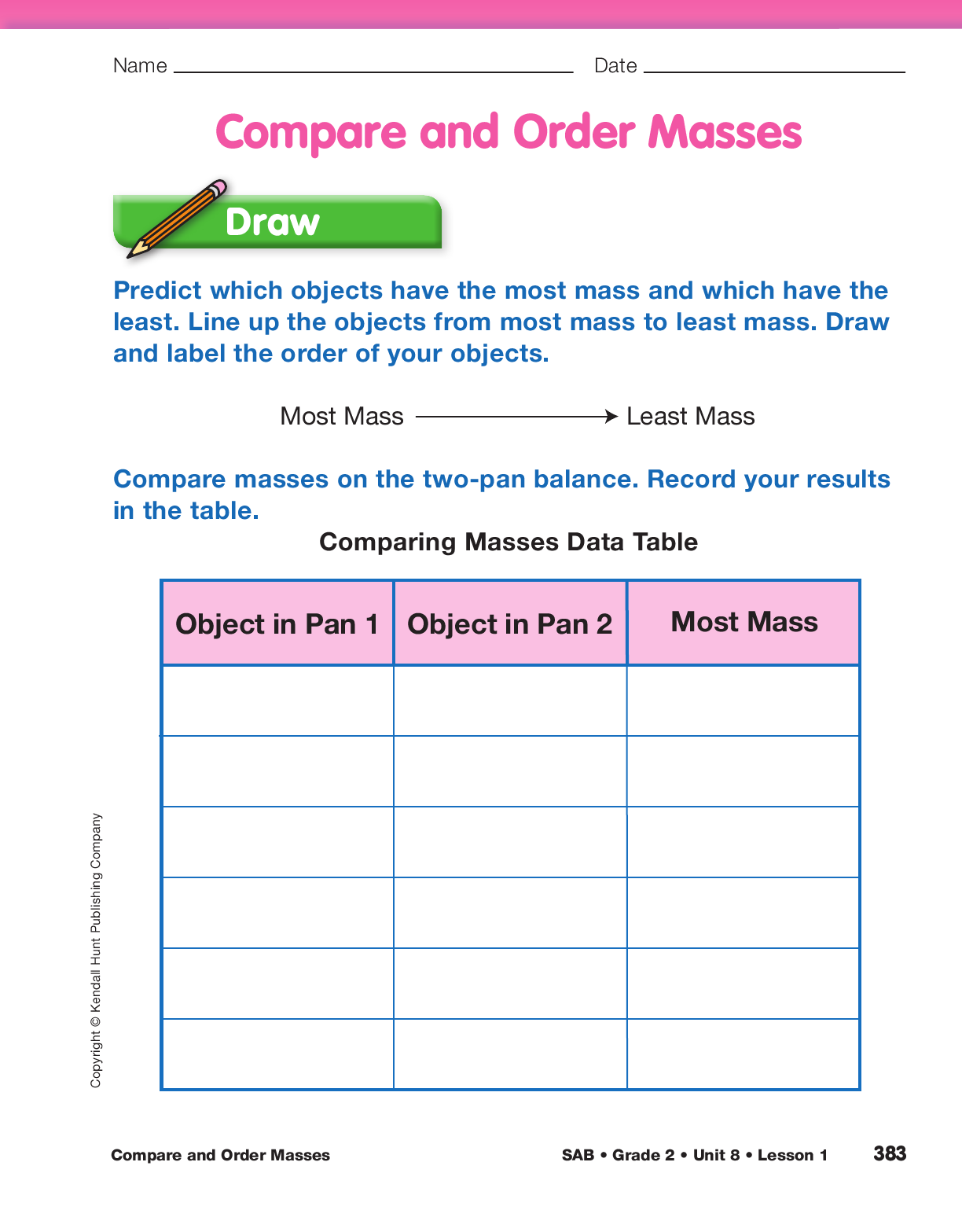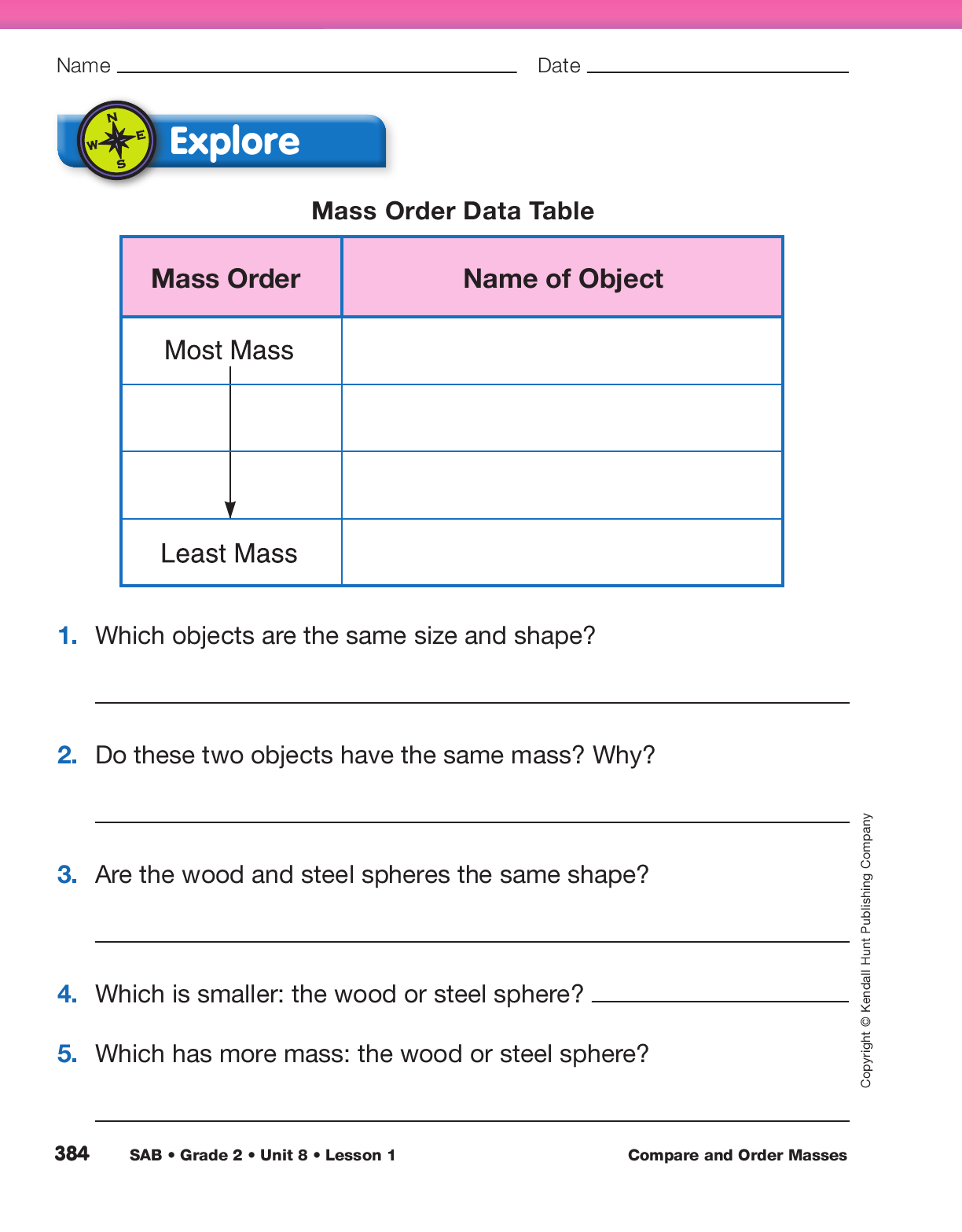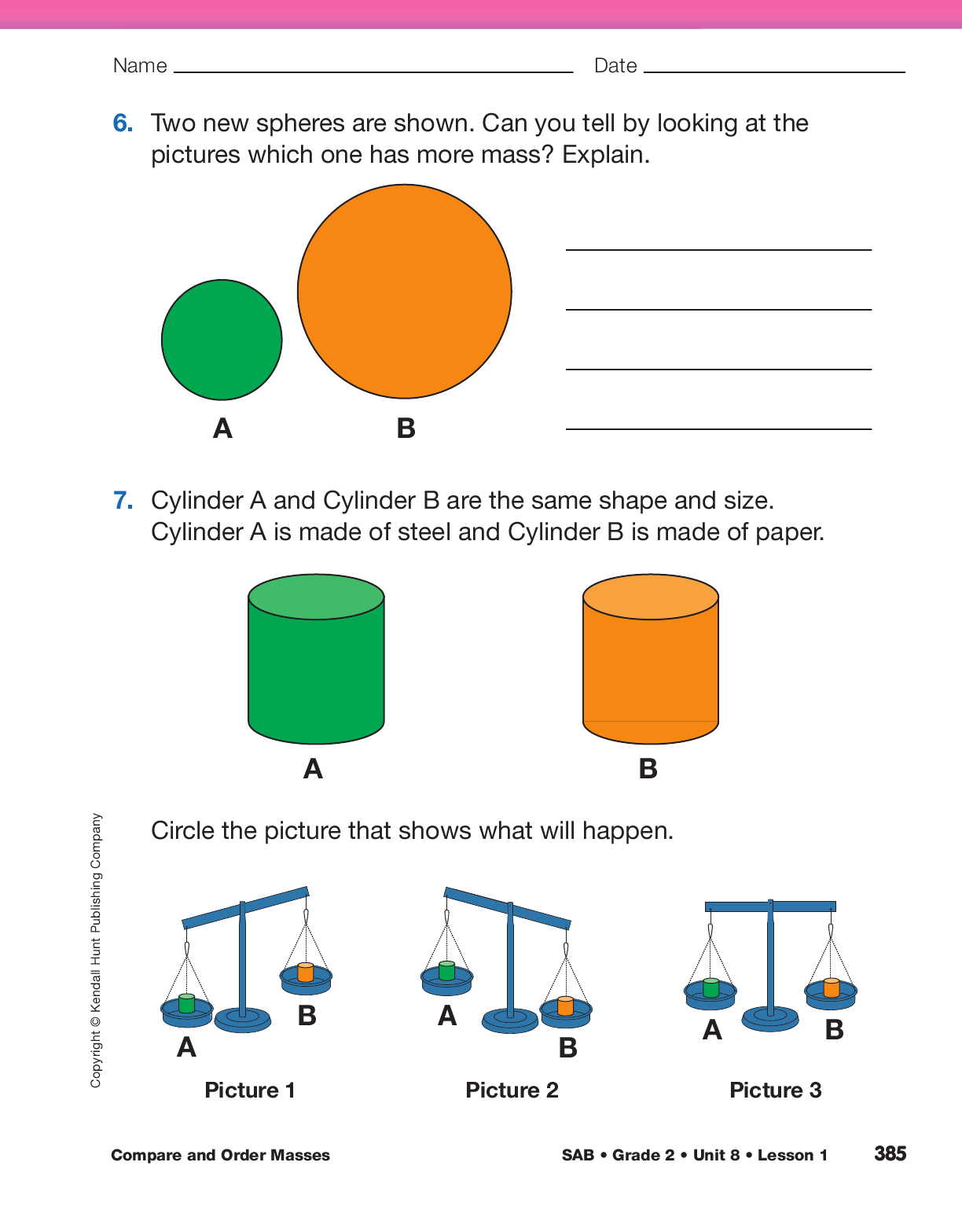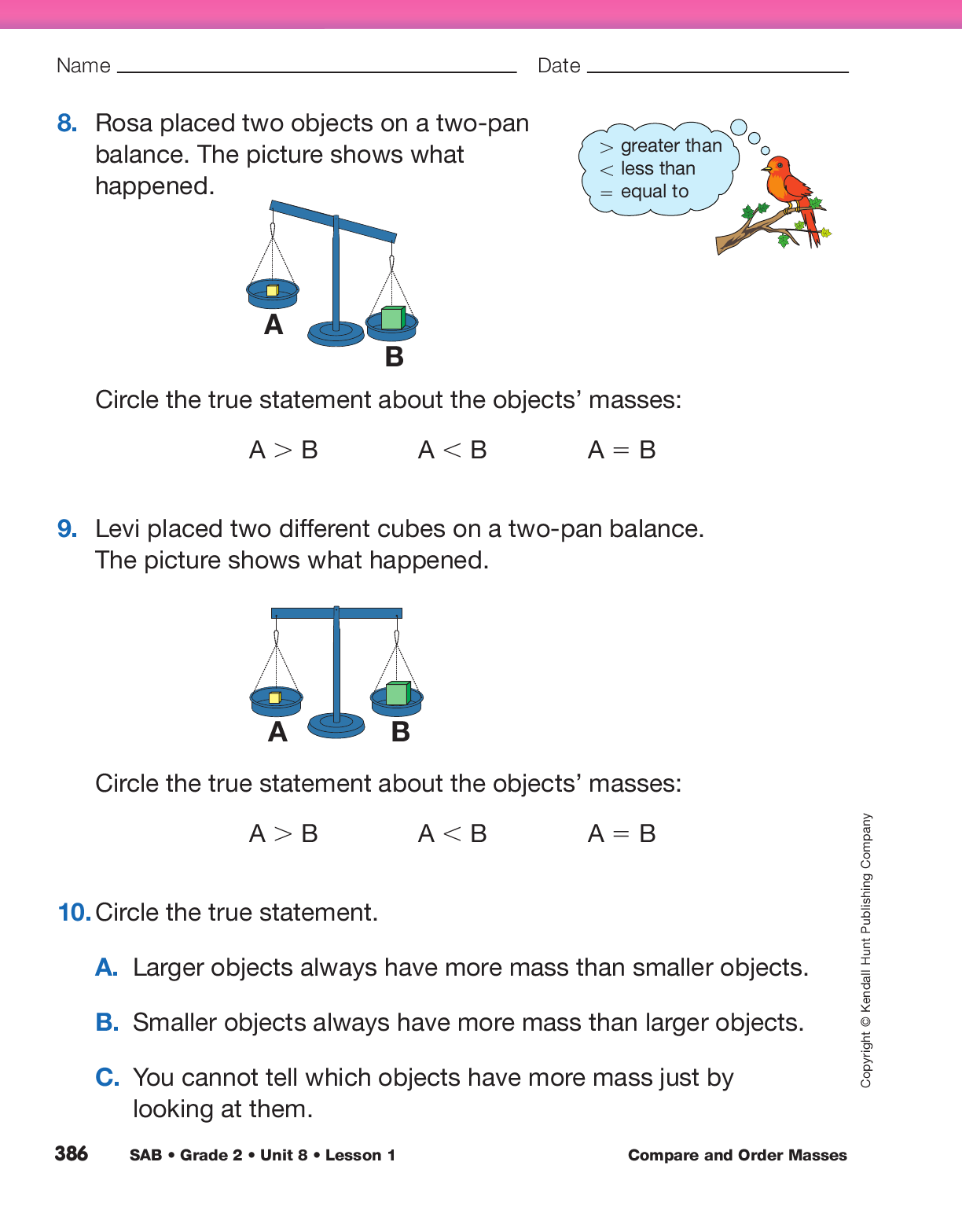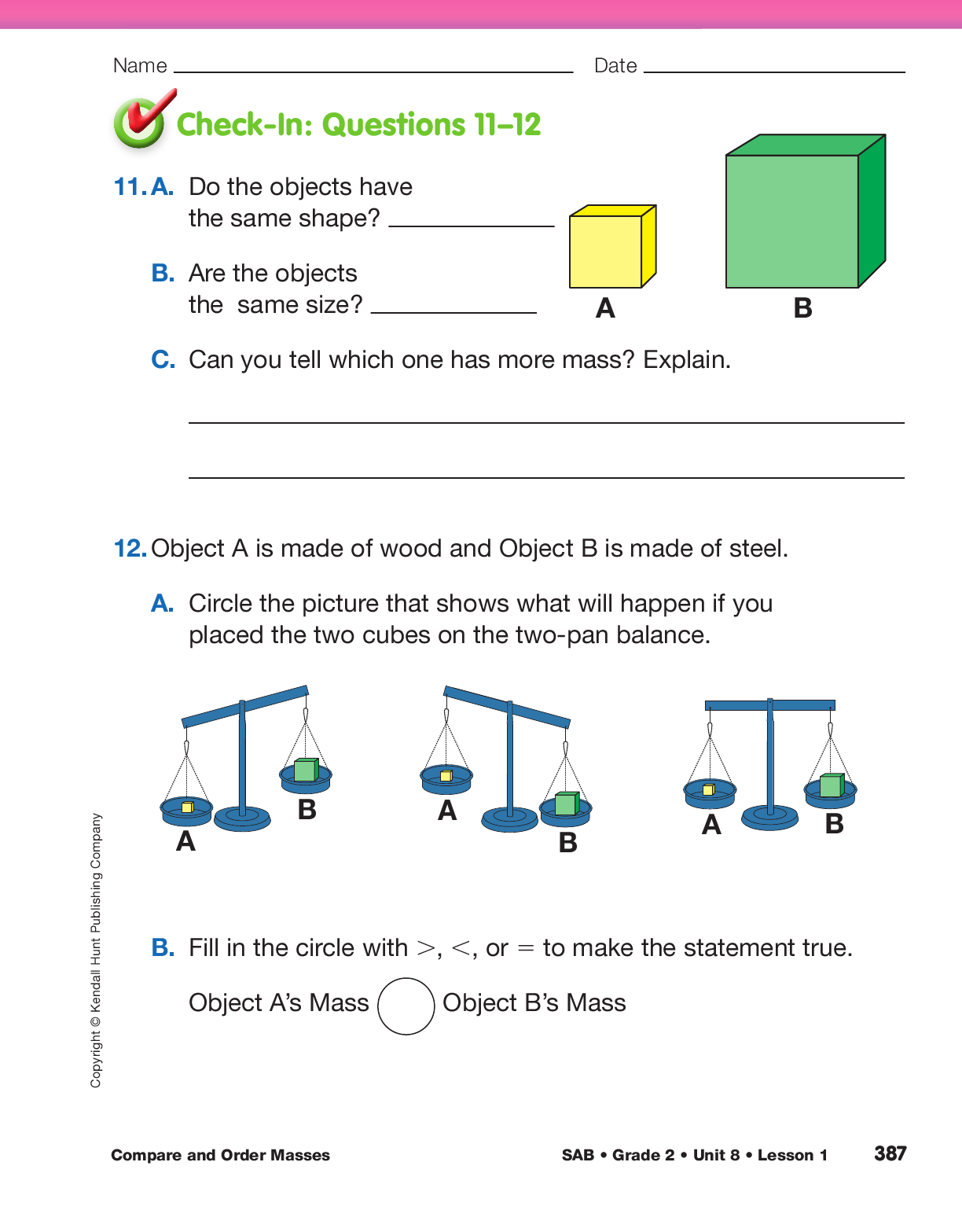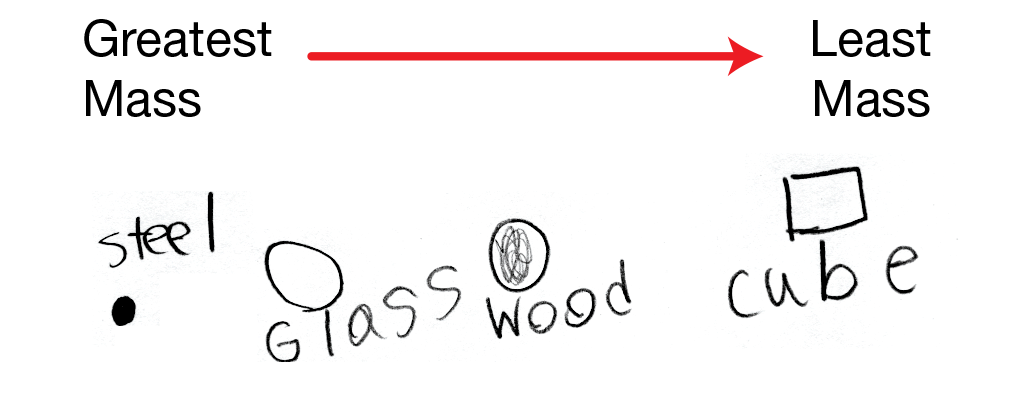Decide if you want students to illustrate their predicted mass
order on the Compare and Order Masses page before or after
students are able to hold the objects in their hands. If
students illustrate their predictions before they are able to
hold the objects, their predictions are based on how the
objects look. If students illustrate their predictions after they
receive the objects, their predictions are based on how the
objects feel in their hands. Using either method, students
verify their predictions by using the two-pan balance.
Predict the Order of Masses.
Introduce the
two-pan balance as a measurement tool used to compare
the mass of two objects. When objects are
placed in each pan, the pan holding the object with
more mass will move down. Show the students the
following objects: a one-inch wood sphere, a
one-inch glass sphere, a half-inch steel sphere, and a
connecting cube. Ask students to predict which
object is heaviest, that is, which one has the most
mass. Have them explain their reasoning. Pay attention
to whether students predict that larger objects
are heavier.
- Which object do you think will have the most
mass? Why do you think so? (Possible response:
Glass, because the glass and wood are the largest
but I think glass is heavier than wood.)
- Which do you think will have the least mass?
Why? (Possible response: I think the connecting
cube will have the least mass because it’s small
and it’s made of plastic.)
- If you order these objects from greatest to least
mass, in what order would you place them?
[Before passing out materials, have students
make predictions about the order of the objects
from greatest to least mass.]
Next, pass out the small containers of sets of objects
to each student pair. Ask them to line up their objects
on their desks in the order they think is greatest mass
to least mass. Students can compare the objects by
holding one in each hand.
- Now that you can compare the objects by holding
one in each hand, did you change your predictions?
(Possible response: Yes. When I looked at
them, I thought the steel sphere had less mass,
but now that I can hold it in my hand, I think it
has more than the wood sphere.)
Have students illustrate their predicted mass order on the
Compare and Order Masses page in the Student Activity Book. See Figure 2 for a sample student drawing.
To line up the objects according to predicted mass, students
can place them between two parallel rulers to prevent the
spheres from rolling away.
The distinction between the concepts of mass and weight is
subtle. Many adults have difficulty articulating it. They are
distinct concepts, yet very similar in the way we experience
them. Do not belabor the point with your students. If they
refer to this activity as “weighing” the items, it is not
necessary to correct them. Continue to use the term “mass”
and include “finding the mass” in your discussions. See
Mathematics in this Unit for a discussion of the difference
between mass and weight.
Find the Order of Masses. Have students use the
two-pan balances to verify their predictions. They
will compare the four objects, two at a time, to determine
which has the most mass. Tell students to keep
track of their comparisons on the Comparing Masses
Data Table on the Compare and Order Masses
pages. There are six possible combinations:
- steel and glass
- steel and wood
- steel and cube
- glass and wood
- glass and cube
- wood and cube
Some students will want to change the drawing of their
predictions on the Compare and Order Masses pages to
match the order they discovered after placing the objects on
the two-pan balance. Explain that when they made a
prediction, it is similar to what scientists do when they make
predictions and then verify their predictions by testing them.
Tell students that once they make their predictions, they do
not have to go back and change them because they record
the final order on the Mass Order Data Table.

To help students find all the possible combinations of objects
to place on the two-pan balance, suggest that they keep an
object in one of the pans until they compare it with the other
objects. For example, keep the steel sphere in one pan and
test it with the glass sphere, wood sphere, and the cube.
Then, they place the steel sphere on the side. Next, they can
take another object, such as the glass sphere, and compare it
with the two remaining objects (wood, cube). Then, they
place that object on the side and test the two remaining
objects.
Let students begin working and devising their own
strategies for putting the objects in order according
to mass. Tell them to start with their predicted order
and make changes as necessary as they work. Let
them experiment with how to rearrange the objects if
they find their predicted order is not correct.
Circulate, answer questions as appropriate, and ask
probing questions to help students think through the
problem.
The strategies students use for this part of the activity
will vary. Some students may find that recording
each comparison on the Comparing Masses Data
Table is useful. Other students may be able to move
the objects after comparing them with the two-pan
balance until the objects are arranged correctly.
Observe students as they place objects on the two-pan
balance and order them according to their masses to assess
students’ understanding of how to measure and compare the
mass of objects using a two-pan balance [E7].
Ask students to record the order from greatest mass
to least mass in the Mass Order Data Table on the
Compare and Order Masses pages. Assign
Questions 1–10 to student pairs. The questions guide
students to use their experiences to draw valid conclusions
and form generalizations. For example, two
objects of the same size and shape but composed of
different materials do not always have the same
mass. For Question 6, guide students to understand
that it is not possible to determine the object that has
more mass because we do not know the material that
makes up the objects in the illustrations. Check-In: Questions 11–12 will be assigned for an assessment
later in the lesson.
Discuss Results. Discuss this activity with students.
Compare their predictions with their results.
- What did you find out about the mass of the
objects? (Possible response: I found out that the
steel ball had more mass than the glass ball.)
- What did you find out about predicting the mass?
(Possible response: You can’t tell which object
has the most mass just by looking at the size or
shape.)
- What would help you predict better: looking at the
object or holding it? Why? (Possible response:
holding it because you can tell the weight of the
object)
- Do bigger objects always have more mass? (no)
How do you know? (Possible response: The tiny
steel sphere is heavier than the bigger objects.)
- Do smaller objects always have more mass? (no)
How do you know? (Possible response: The cube
is smaller than the glass ball and the cube has
less mass. You can’t tell which has more mass by
its size.)
- Do the same size objects always have the same
mass? (no) How do you know? (Possible
response: The glass ball and the wood ball are the
same size, but the glass ball is heavier.)
- What happens to a two-pan balance when you
place objects with different masses in the pans?
(Possible response: The side that has more mass
goes down and the side with less mass goes up. If
they have the same mass, the arm is level.)
Assign Check-In: Questions 11–12 on the Compare
and Order Masses pages in the Student Activity Book
to assess students’ understanding of the expectations
in this lesson.
Use the Check-In: Questions 11–12 on the Compare and
Order Masses pages in the Student Activity Book to assess
students’ abilities to use words and symbols (e.g., <, >, =)
to show comparisons of quantities [E2] and measure and
compare the mass of objects using a two-pan balance [E7].
For targeted practice place a two-pan balance, various
objects, and copies of the
Compare Objects Master in a
center to provide practice with comparing and ordering the
mass of objects.
















